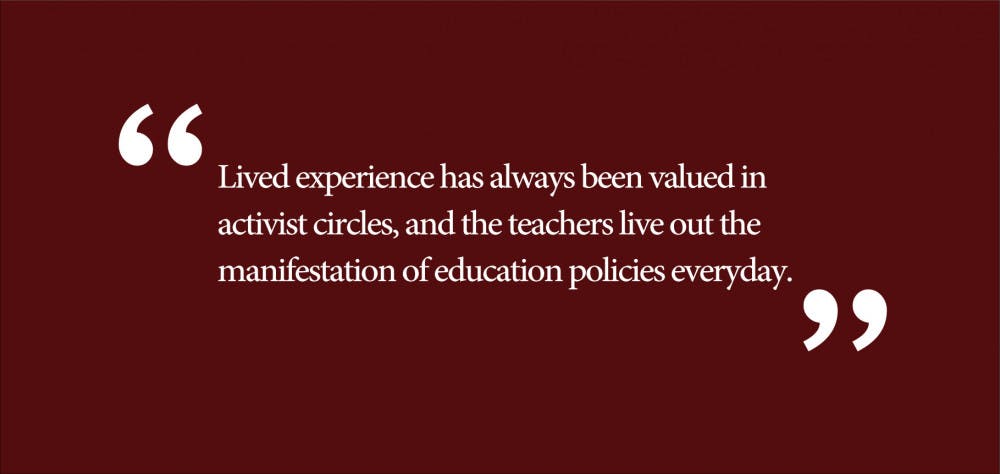The Los Angeles teachers’ strike ended Tuesday night after six days of picketing. Teachers and other educators returned Wednesday to classrooms having successfully earned from the district smaller class sizes, a six-percent raise and more counselors, librarians and nurses. As a daughter of a school psychologist who was on strike and a student who spent 13 years in public schools, I wholeheartedly support the union of United Teachers Los Angeles and the teachers’ strike. The agreement on Tuesday is a step in the right direction for the future of the district and education policy as a whole. I am grateful that I had the opportunity to participate in the strike firsthand, as this experience solidified my solidarity with the educators of the Los Angeles Unified School District.
Teachers, substitutes, counselors, librarians, nurses and psychologists began to strike last Monday at every LAUSD school site, according to UTLA. My mom and I woke up at 6 a.m. to unusual Southern California pouring rain, so it took special determination to step outdoors. We drove down to the sidewalk outside of one of the two schools where she works. There, we picketed for two hours outside the gates of the school, chanting “U - T - L - A” and holding signs that read “On Strike for Our Students.” After the morning picket line, over 50,000 people flooded the streets of Downtown Los Angeles in a march to the district headquarters. The crowd bustled with energy, a sea of umbrellas and rain ponchos set to a roar of drumbeats and chants. Students, community members and other labor unions such as the International Brotherhood of Teamsters were present in support of the rally. This process continued in a similar fashion all of last week. Strike participants did not enter schools for six days, forgoing their pay in the process. The volume of the strike — 30,000 participating educators — should be the first indication of its importance.
Substitutes from other districts and non-union district workers supervised students who attended schools during the strike — but not all of them showed up. LAUSD loses money from the state for each student absence, so UTLA encouraged students and parents to join their teachers on the picket line. Elsewhere in the city, support for the movement swelled: Several museums around the city offered free admission to students not attending school in a demonstration of solidarity.
The teacher’s strike in Los Angeles is both historic and indicative of a national trend. UTLA hasn’t gone on strike in thirty years. In fact, while we were picketing Monday, a former teacher who took part in the 1989 strike came out and offered words of support to the teachers. As the second largest district in the nation, LAUSD is a flashpoint into the broader educational labor movement, with teachers nationwide paying rapt attention to the strike. Denver teachers voted Wednesday to begin a strike, with teachers in Oakland set to vote as well. Earlier this school year, teachers across West Virginia, Oklahoma and Arizona also went on massive strikes.
These movements show a shift in the national conversation surrounding public education, a long-neglected issue in the country. Current Secretary of Education Betsy DeVos is a champion of school choice, which pulls funding out of public education and into private and charter schools. Rather than divert funding from public schools, lawmakers need to reinvest in the current public system. The benefits from increased funding are manifold: smaller class sizes, higher wages and an expansion in support staff.
Many students at Brown attended private or charter schools and are perhaps unaware of the realities that regular public schools and their students face. California is 41st in the nation in per-student spending on education; LAUSD students are an unfortunate example of those affected by this lack of investment. The district serves a diverse population of over 600,000 students across more than 1,000 schools in neighborhoods of all types. Many teachers’ signs at the rally reiterated the idea that the teachers are on strike for their students and are spending valuable time away from the classroom out of necessity.
The teachers’ strike asked for this investment in public education from the district and was largely successful in achieving its demands. Before striking, most schools only had a nurse on site one day per week. Now, the district is hiring 300 additional nurses to ensure that each school has a nurse. Furthermore, 77 more counselors will be hired over the next few years.
However, not everyone is satisfied with the deal: The priorities of school psychologists were relegated to the sideline. The 6 percent raise is lower than the requested 6.5 percent, and the raise is long overdue — especially in a city as expensive to live in as Los Angeles.
Teachers should be considered the premier authority on education policy because of their experience in the classroom. Lived experience has always been valued in activist circles, and teachers live out the manifestation of education policies every day. Never a priority in America, educators have been ignored and sidelined for years. Now, with the successful strike in Los Angeles, we have a unique and groundbreaking example of the power of teachers to effect change. The union has been successful in achieving its primary goals. This is the beginning of several important conversations regarding public education, and I hope to see public educators across the nation achieve similar victories.
Amelia Anthony ‘22 can be reached at amelia_anthony@brown.edu. Please send responses to this opinion to letters@browndailyherald.com and op-eds to opinions@browndailyherald.com.





